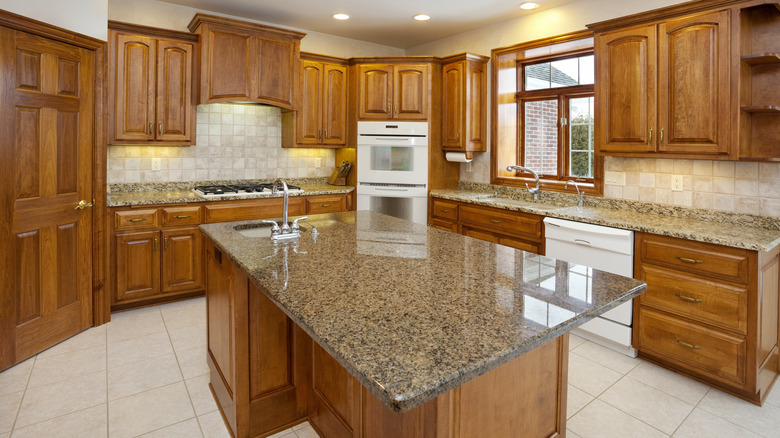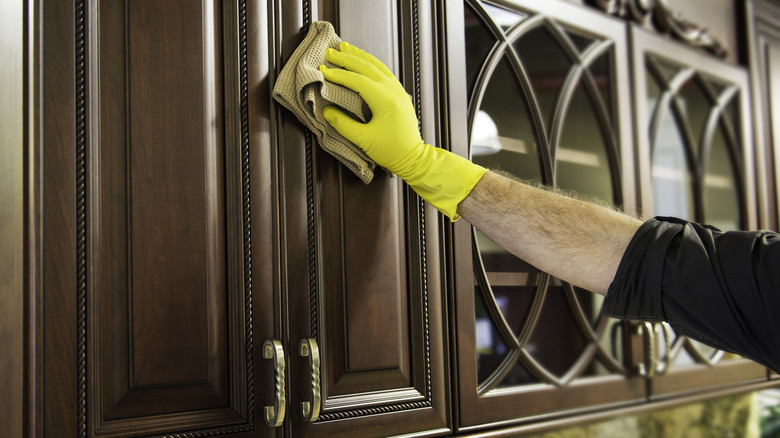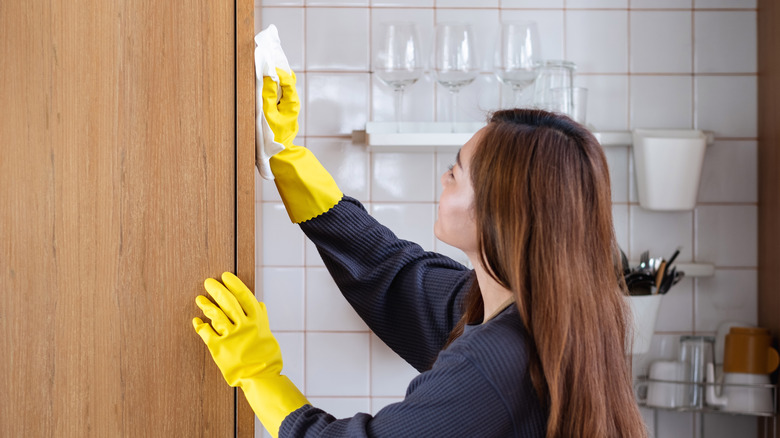Why You Should Think Twice Before Using Vinegar To Clean Waxed Wood Cabinets
Wooden cabinets, such as those in the kitchen or wet bar area of your home, can become dirty quickly, especially in areas where you use them often or when they're near an area where dirt and grime can build up. Some cabinetry has a wax coating on it, which helps to provide some level of protection for the wood underneath from water and other types of damage. However, when cleaning this surface, you'll want to avoid using products that can damage that wax coating, or the wood under it, like vinegar.
Vinegar is a surprisingly damaging material for waxed wooden cabinet surfaces, as it's potent enough to eat into the surface, creating pitting and damage overall. If you spill a bit of vinegar onto a cabinet like this, you'll likely notice no damage. However, with constant cleaning, vinegar can cause significant damage by virtually eliminating the protective wax coating. It can be a versatile cleaning tool for sanitizing cutting boards or even descaling the buildup in the coffee maker, though you should test it in a hidden spot before doing so to ensure it doesn't damage the type of coating.
Why vinegar could damage waxed wood cabinets
Vinegar may seem like a benign and simple-to-use cleaning agent. However, it's made during a fermentation process involving acetic acid. The fermentation process, completed over several weeks, develops the flavor of this liquid, but that acid is powerful enough to eat through various materials, including wax.
The acidic makeup of vinegar is often more powerful than you think. Though it's fantastic at killing some bacteria, it's also strong enough to create corrosion on some stone and wood and destroy the wax covering on the wood cabinets. This often leaves the surface looking dull and even stained. It may look damaged from moisture, too. Once the vinegar breaks through the wax, damage can continue to the now-unsealed wood, which will absorb much of the vinegar. Over time, this can cause the wood to swell up and become so fragile that it cracks or splits open.
If you happen to get vinegar on the surface of your wax cabinetry of any type, wipe it off quickly and rinse it to minimize this risk. Most often, though, it takes more than a few seconds for the vinegar to penetrate the wax and wood surface. Even if you dilute the vinegar in plenty of water, there's still some risk. More so, if you dilute vinegar too much to reach this level, you're losing all of the cleaning benefits it typically offers.
How to clean wax wood cabinets without risk
It's not uncommon for older kitchen cabinets to have a wax covering on them. Some have a varnished or a lacquer finish on them as well, with wax covering it. As noted, unless you want to remove the wax coating, you'll want to avoid using vinegar, but there are other safe ways to remove caked-on grime and grease.
The first step to cleaning wood cabinets is to use a mild soap, like dish soap, to cleanse the solution. Simply add a few teaspoons into warm water and use a non-abrasive cloth to wash the surface. Too much moisture or any type of abrasive scrub may cause damage to the surface of the cabinetry. Also, consider hardwood cleaners that specifically state they can be used on waxed wood surfaces like this.
When there's a significant amount of dirt and grime, especially if that material has bonded with the wax, it's often easier to remove the wax and start over. In particularly older cabinets, this could be a good way to bring them back to a usable, durable condition. This process includes stripping the wax and potentially applying a restoration-quality protective coating, like a conversion varnish, on the surface to create a new layer of protection. Also note that if your cabinetry isn't older, it's best to check with the manufacturer to determine the proper cleaning and maintenance of these cabinets, especially if you have a warranty on them.


